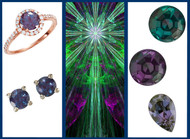"Emerald by day, ruby by night" is what most gem fans call the Alexandrite gemstone because it changes colors with the light around it. If you've ever seen this stone in person, you would know how unbelievably beautiful it is to the eye. There are other color changing gemstones, but this is one that has the most intense transformation. Let's learn a little bit more about the beautiful Alexandrite.

It was discovered in 1830 in Russia's Ural Mountains and named after the Czar Alexander II. Some of the finest and brilliant colored alexandrites came from the mines in Russia. However, today most alexandrites are mined in Sri Lanka, East Africa, and Brazil which tend to be less vibrant color changes compared to those from Russia. Alexandrites mined in these locations tend to be more brownish or purplish red.
Most natural alexandrites are under 1.0 carats. The largest alexandrite mined to-date is 65.7 carats and was found in Sri Lanka. Russian alexandrites are usually around 30 carats, rarer, and more vibrant in color.
Alexandrite is a rare color changing variety of the mineral chrysoberyl. In daylight or fluorescent light, the color is more green; while in incandescent light or evening, you will see more brownish-purplish red in the stone The stone has unusual light absorbing properties which is one reason many love the gemstone.

Along with pearl and moonstone, alexandrite is a June birthstone and used to celebrate a 55th wedding anniversary. Just a few things to know about this beautiful gemstone that works with any piece of jewelry and rarely celebrated among jewelry fanatics.

